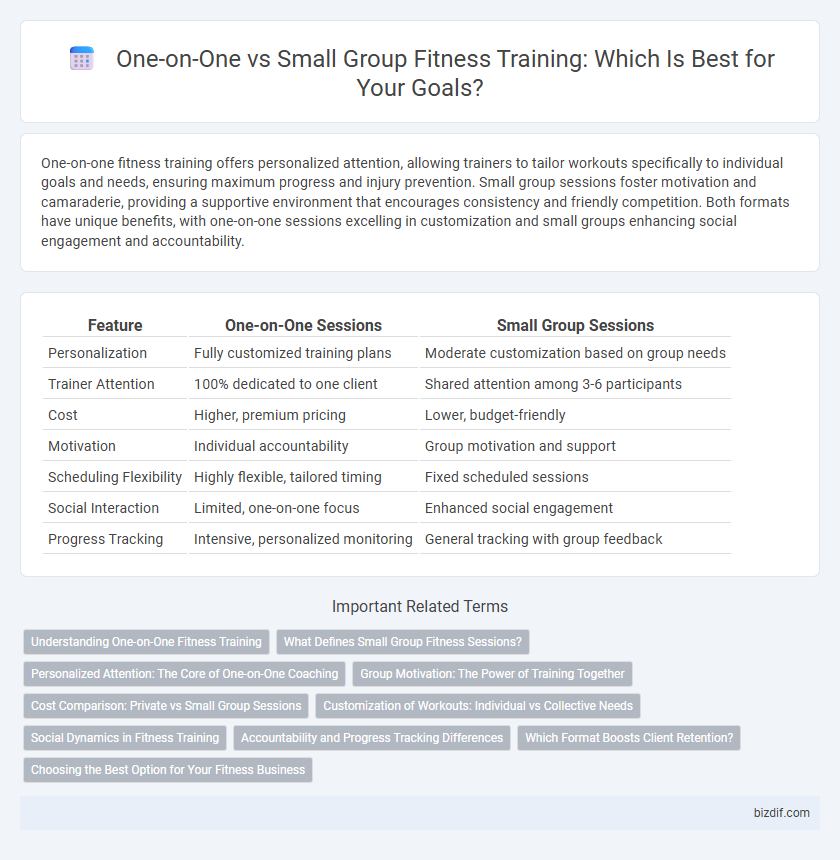One-on-one fitness training offers personalized attention, allowing trainers to tailor workouts specifically to individual goals and needs, ensuring maximum progress and injury prevention. Small group sessions foster motivation and camaraderie, providing a supportive environment that encourages consistency and friendly competition. Both formats have unique benefits, with one-on-one sessions excelling in customization and small groups enhancing social engagement and accountability.
Table of Comparison
| Feature | One-on-One Sessions | Small Group Sessions |
|---|---|---|
| Personalization | Fully customized training plans | Moderate customization based on group needs |
| Trainer Attention | 100% dedicated to one client | Shared attention among 3-6 participants |
| Cost | Higher, premium pricing | Lower, budget-friendly |
| Motivation | Individual accountability | Group motivation and support |
| Scheduling Flexibility | Highly flexible, tailored timing | Fixed scheduled sessions |
| Social Interaction | Limited, one-on-one focus | Enhanced social engagement |
| Progress Tracking | Intensive, personalized monitoring | General tracking with group feedback |
Understanding One-on-One Fitness Training
One-on-one fitness training provides personalized attention, allowing trainers to tailor workouts specifically to an individual's goals, fitness level, and health conditions. This focused approach enhances motivation, corrects form in real-time, and maximizes workout efficiency. Research shows that personalized guidance in one-on-one settings often leads to faster progress and reduced injury risk compared to small group sessions.
What Defines Small Group Fitness Sessions?
Small group fitness sessions typically involve 3 to 8 participants working out together under the guidance of a certified trainer, creating a more personalized yet social environment compared to large classes. These sessions balance individual attention with group motivation, fostering accountability and camaraderie while allowing tailored workout adjustments based on each participant's fitness level. Small group training often emphasizes functional movements, strength building, and cardiovascular conditioning, optimized for varied goals within a supportive community setting.
Personalized Attention: The Core of One-on-One Coaching
One-on-one fitness training offers unmatched personalized attention, allowing coaches to tailor workouts precisely to individual goals, fitness levels, and limitations. This focused approach enhances technique correction, motivation, and progress tracking, resulting in faster and safer improvements. Small group sessions often lack this degree of customization, making one-on-one coaching the preferred choice for those seeking highly specific guidance and accountability.
Group Motivation: The Power of Training Together
Training in small group sessions enhances motivation through shared energy and accountability, driving participants to push beyond individual limits. One-on-one sessions offer personalized guidance but can lack the dynamic encouragement found in group settings. The collective atmosphere in group workouts fosters camaraderie and sustained commitment, leveraging social interaction for improved fitness results.
Cost Comparison: Private vs Small Group Sessions
Private fitness sessions typically cost between $50 to $100 per hour, reflecting personalized attention and tailored workouts, whereas small group sessions generally range from $15 to $40 per participant, offering a more affordable option with shared resources. The per-person price in small group training decreases as group size increases, making it cost-effective for budget-conscious clients seeking social motivation. Clients must weigh the higher cost of one-on-one training against the personalized guidance it provides compared to the communal benefits and reduced rates found in group settings.
Customization of Workouts: Individual vs Collective Needs
One-on-one fitness sessions offer personalized workout plans tailored to an individual's specific goals, fitness level, and medical history, ensuring maximum effectiveness and safety. Small group sessions provide a semi-customized approach, balancing individual attention with group motivation but may require standardized exercises that fit the majority rather than unique needs. Customization in one-on-one training optimizes progress by addressing personal strengths and weaknesses, whereas small group settings foster a collective dynamic that supports general fitness improvements.
Social Dynamics in Fitness Training
One-on-one fitness training offers personalized attention, allowing trainers to tailor workouts precisely to individual goals and needs, enhancing motivation and accountability. Small group sessions foster a supportive community atmosphere, promoting social interaction and healthy competition that can boost overall engagement and perseverance. Both formats leverage social dynamics differently, with individualized focus driving personal progress and group settings enhancing social connection and collective encouragement.
Accountability and Progress Tracking Differences
One-on-one fitness training sessions provide personalized accountability with a dedicated coach tracking individual progress in detail through customized workout adjustments and frequent assessments. Small group sessions offer shared motivation and a collective accountability environment but may limit the trainer's ability to monitor and tailor progress tracking for each participant. Personalized feedback and consistent progress evaluations remain more precise in one-on-one settings, enhancing goal achievement efficiency.
Which Format Boosts Client Retention?
One-on-one fitness training offers personalized coaching tailored to individual goals, which enhances motivation and accountability, leading to higher client retention rates. Small group sessions foster a sense of community and social support, increasing engagement and long-term commitment. Research indicates that while both formats improve retention, the personalized attention in one-on-one training typically results in greater client loyalty and sustained progress.
Choosing the Best Option for Your Fitness Business
One-on-one fitness training sessions offer personalized coaching, tailored workout plans, and direct client-trainer interaction, ideal for clients seeking customized attention and faster progress. Small group sessions provide a cost-effective approach, fostering community motivation and social engagement while allowing trainers to manage multiple clients simultaneously. Fitness businesses should assess client goals, budget constraints, and desired trainer-to-client ratios to determine the most efficient service model that maximizes both client satisfaction and revenue.
One-on-One Sessions vs Small Group Sessions Infographic

 bizdif.com
bizdif.com